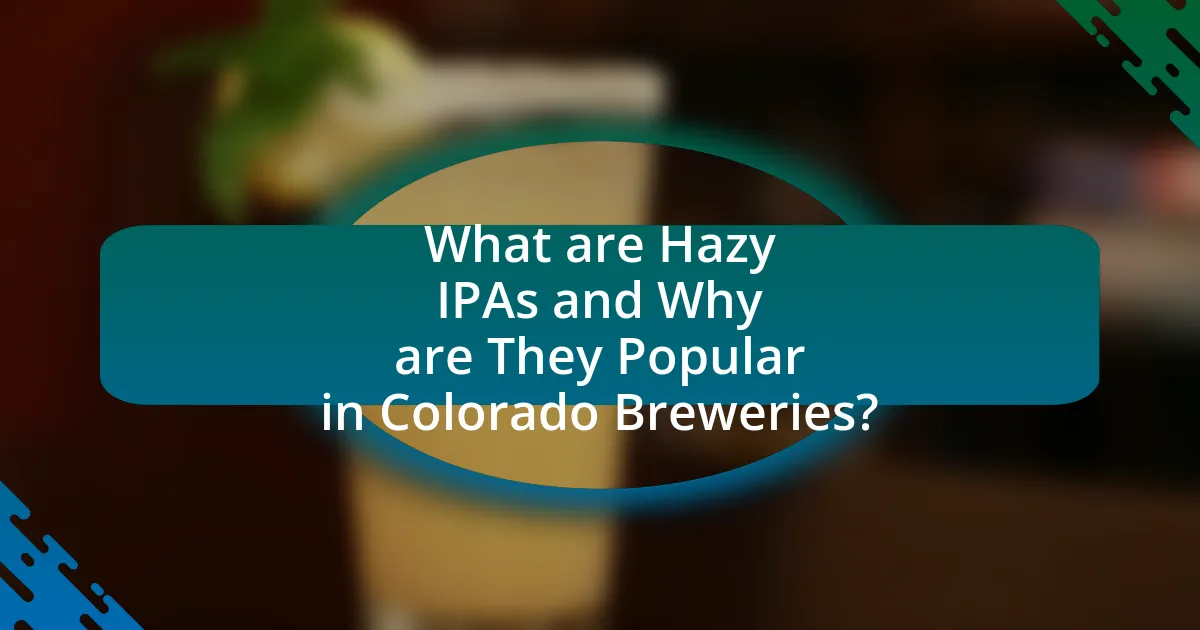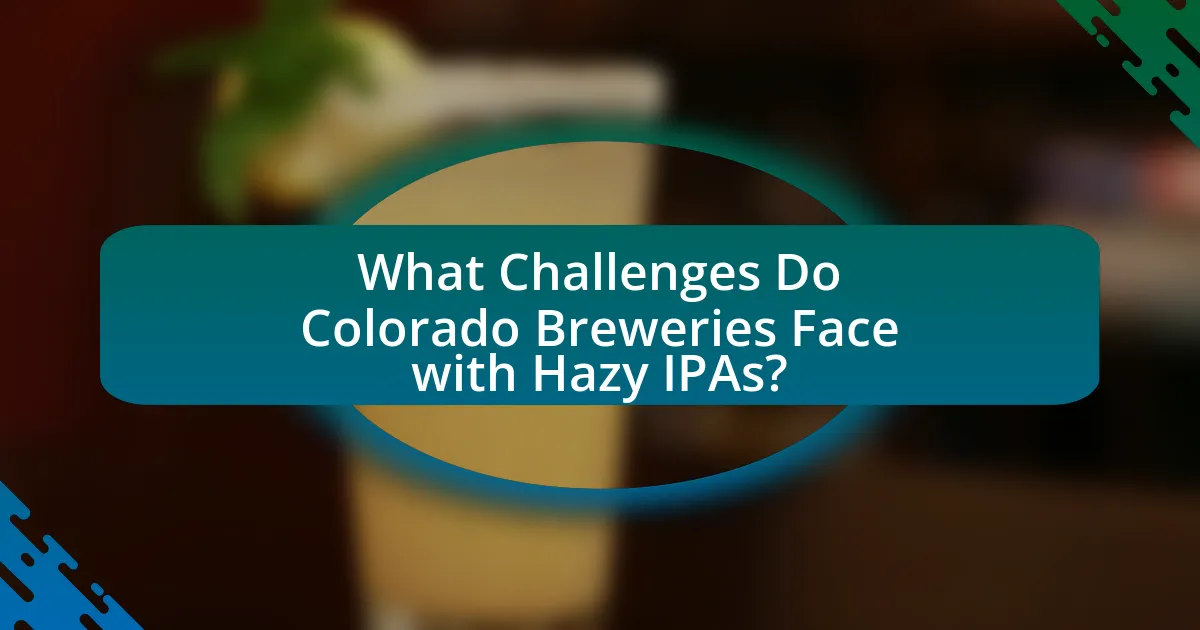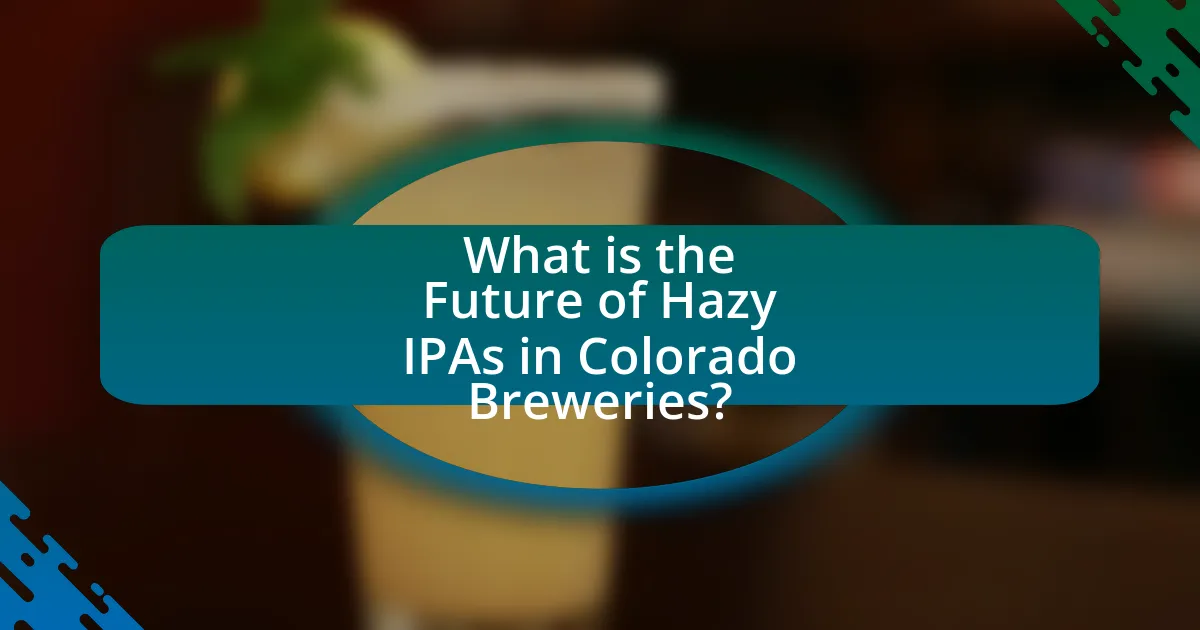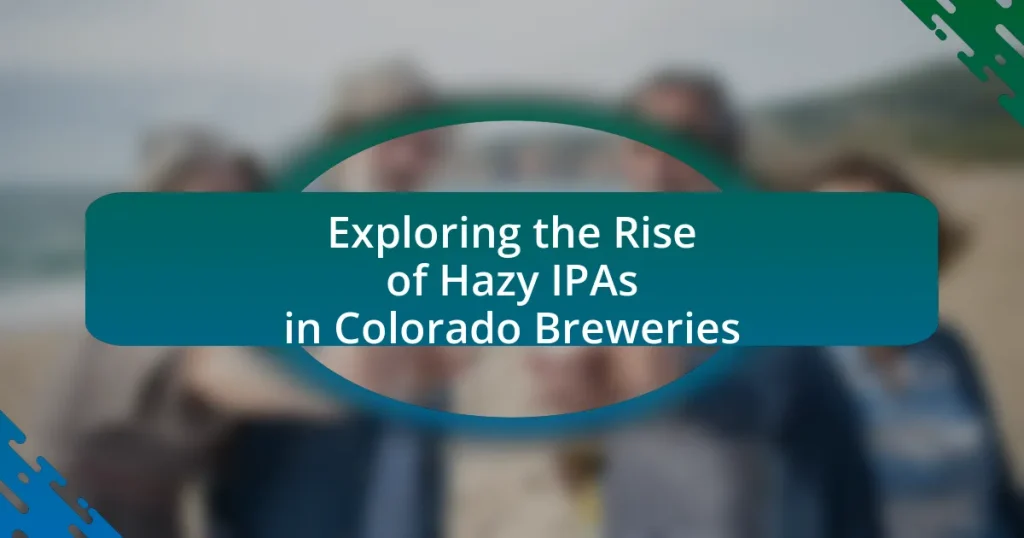Hazy IPAs, also known as New England IPAs, are a popular style of India Pale Ale characterized by their cloudy appearance, juicy flavors, and low bitterness, particularly thriving in Colorado’s craft beer scene. This article explores the emergence of Hazy IPAs, their defining characteristics, and the reasons behind their growing consumer preference. It examines the role of Colorado breweries in innovating and popularizing this style, the unique ingredients they use, and the trends influencing production. Additionally, the article addresses challenges faced by breweries, including ingredient sourcing and regulatory issues, while looking ahead to the future of Hazy IPAs in the state.

What are Hazy IPAs and Why are They Popular in Colorado Breweries?
Hazy IPAs, also known as New England IPAs, are a style of India Pale Ale characterized by their cloudy appearance, juicy flavor profile, and low bitterness. Their popularity in Colorado breweries stems from the state’s vibrant craft beer culture and the demand for innovative, flavorful beers. Colorado’s breweries have embraced Hazy IPAs due to their appeal to a broad audience, as these beers often feature tropical fruit notes and a smooth mouthfeel, making them accessible to both seasoned craft beer drinkers and newcomers. The state’s favorable brewing conditions and a strong community of craft beer enthusiasts further contribute to the rise of Hazy IPAs in the region.
How did Hazy IPAs emerge in the craft beer scene?
Hazy IPAs emerged in the craft beer scene as a response to the growing demand for juicy, aromatic beers that prioritize hop flavor over clarity. This style gained popularity in the early 2010s, particularly in the Northeast United States, with breweries like The Alchemist and Tree House Brewing Company leading the charge. The use of specific grains, such as oats and wheat, along with dry hopping techniques, contributed to the hazy appearance and enhanced mouthfeel, distinguishing Hazy IPAs from traditional IPAs. The trend quickly spread to other regions, including Colorado, where local breweries adopted and adapted the style, further solidifying its place in the craft beer landscape.
What characteristics define a Hazy IPA?
Hazy IPAs are characterized by their cloudy appearance, juicy flavor profile, and low bitterness. The cloudiness results from the use of specific grains, such as oats and wheat, along with dry hopping techniques that introduce suspended particles. Juicy flavors are achieved through the use of hop varieties that impart tropical and citrus notes, while the bitterness is typically subdued compared to traditional IPAs, often measuring around 30-50 IBU. This combination of traits has contributed to the popularity of Hazy IPAs, particularly in craft beer markets like Colorado, where breweries have embraced this style to attract a diverse range of consumers.
Why do consumers prefer Hazy IPAs over other styles?
Consumers prefer Hazy IPAs over other styles primarily due to their unique flavor profiles and mouthfeel. Hazy IPAs are characterized by their juicy, fruity flavors, which result from the use of specific hop varieties and brewing techniques that emphasize aroma over bitterness. This style often features tropical and citrus notes, appealing to those who enjoy a more approachable and less bitter beer experience. Additionally, the smooth, creamy texture of Hazy IPAs enhances drinkability, making them popular among craft beer enthusiasts. The rise in popularity is also supported by market trends indicating a significant increase in sales of Hazy IPAs, reflecting consumer preference for this style in recent years.
What role do Colorado breweries play in the rise of Hazy IPAs?
Colorado breweries are pivotal in the rise of Hazy IPAs, significantly contributing to their popularity and innovation. The state’s craft beer scene, characterized by a strong emphasis on experimentation and quality, has led to the development of unique Hazy IPA recipes that appeal to a broad audience. Notably, breweries like New Belgium and Odell have embraced this style, showcasing their commitment to pushing the boundaries of traditional brewing. The Colorado Brewers Guild reported that Hazy IPAs accounted for a substantial percentage of the craft beer market in the state, reflecting consumer demand and the breweries’ responsiveness to trends. This combination of creativity and market adaptation has solidified Colorado’s reputation as a leader in the Hazy IPA movement.
How have local breweries contributed to the popularity of Hazy IPAs?
Local breweries have significantly contributed to the popularity of Hazy IPAs by innovating brewing techniques and creating unique flavor profiles that appeal to consumers. These breweries often experiment with various hops and brewing methods, resulting in a diverse range of Hazy IPAs that attract craft beer enthusiasts. For instance, the use of late hop additions and dry hopping enhances the aroma and flavor, making these beers more appealing. Additionally, local breweries frequently engage with their communities through tastings and events, fostering a culture of craft beer appreciation that further boosts the demand for Hazy IPAs. This grassroots approach has led to a notable increase in the availability and visibility of Hazy IPAs in the market, solidifying their popularity among consumers.
What unique ingredients are used by Colorado breweries in their Hazy IPAs?
Colorado breweries often use unique ingredients such as locally sourced fruits, spices, and experimental hops in their Hazy IPAs. For instance, some breweries incorporate Colorado-grown peaches or apricots to enhance the fruity profile, while others experiment with hops like Sabro and Idaho 7, which provide distinct tropical and citrus notes. Additionally, certain breweries utilize oats and wheat to create a smooth mouthfeel, contributing to the characteristic haze of these IPAs. This combination of local produce and innovative hop varieties reflects the creative approach of Colorado’s craft beer scene.
What trends are influencing the production of Hazy IPAs in Colorado?
The production of Hazy IPAs in Colorado is influenced by several key trends, including the growing consumer preference for juicy and fruity flavors, the use of innovative hop varieties, and the emphasis on brewing techniques that enhance haze and mouthfeel. Consumer demand for Hazy IPAs has surged, with sales increasing by over 50% in recent years, reflecting a shift towards more approachable and aromatic beer styles. Additionally, brewers are experimenting with new hop strains, such as Sabro and Strata, which contribute unique tropical and citrus notes, further driving interest in this style. Techniques like dry hopping and the use of adjuncts, such as oats and wheat, are also being adopted to achieve the desired haze and creamy texture, aligning with current market trends favoring smooth and flavorful beers.
How are consumer preferences shaping Hazy IPA recipes?
Consumer preferences are significantly shaping Hazy IPA recipes by driving brewers to prioritize juicy, fruity hop profiles and lower bitterness levels. As consumers increasingly favor smooth, aromatic beers with tropical and citrus notes, breweries are adapting their recipes to include hop varieties like Citra, Mosaic, and Galaxy, which enhance these flavor characteristics. Additionally, the demand for hazy appearances has led to the use of specific grains and adjuncts, such as oats and wheat, which contribute to the desired mouthfeel and haze. This trend is supported by market research indicating that Hazy IPAs have become one of the fastest-growing segments in the craft beer industry, reflecting a clear consumer preference for this style.
What innovations are breweries implementing in Hazy IPA brewing techniques?
Breweries are implementing innovations in Hazy IPA brewing techniques by utilizing advanced hop products, such as cryo hops and hop oils, to enhance aroma and flavor while minimizing bitterness. These innovations allow for a more intense hop character without the astringency often associated with traditional hopping methods. Additionally, some breweries are experimenting with new yeast strains that contribute to the haze and mouthfeel, as well as employing techniques like biotransformation, where yeast interacts with hops during fermentation to create unique flavor profiles. These methods have been shown to improve the overall quality and appeal of Hazy IPAs, aligning with consumer preferences for juicy, aromatic beers.

What Challenges Do Colorado Breweries Face with Hazy IPAs?
Colorado breweries face several challenges with hazy IPAs, primarily related to consistency, ingredient sourcing, and market saturation. The hazy IPA style requires precise brewing techniques to achieve the desired turbidity and flavor profile, which can lead to variability in batches. Additionally, sourcing high-quality hops and adjuncts that contribute to the haze can be difficult, especially as demand for these ingredients increases. Furthermore, the craft beer market in Colorado is highly competitive, with many breweries producing similar styles, making it challenging for individual breweries to differentiate their hazy IPAs and maintain consumer interest.
How do production costs affect Hazy IPA offerings?
Production costs significantly influence Hazy IPA offerings by determining pricing strategies and ingredient selection. Higher production costs, often due to the use of specialty grains, hops, and yeast required for the hazy style, can lead breweries to either increase prices or limit the variety of Hazy IPAs they produce. For instance, the demand for high-quality, fresh hops has surged, with some varieties costing up to 50% more than standard hops, impacting the overall cost structure. Consequently, breweries may opt for fewer experimental brews or adjust their recipes to maintain profitability while still appealing to consumers.
What are the challenges in sourcing ingredients for Hazy IPAs?
The challenges in sourcing ingredients for Hazy IPAs include the availability of specific hops, the quality of adjuncts, and the consistency of raw materials. Hazy IPAs typically require unique hop varieties, such as Citra and Mosaic, which can be subject to supply fluctuations due to climate conditions and agricultural yields. Additionally, the use of adjuncts like oats and wheat for mouthfeel and haze can vary in quality, impacting the final product. Furthermore, maintaining a consistent supply chain for these ingredients is crucial, as any disruption can affect production schedules and the overall quality of the beer.
How do breweries maintain quality control with Hazy IPAs?
Breweries maintain quality control with Hazy IPAs by implementing rigorous testing protocols throughout the brewing process. These protocols include regular monitoring of key parameters such as pH levels, specific gravity, and yeast viability, which are essential for ensuring the desired flavor profile and stability of the beer. Additionally, breweries often conduct sensory evaluations and taste tests to assess the aroma and mouthfeel, which are critical characteristics of Hazy IPAs. Quality assurance measures, such as batch consistency checks and microbial testing, further ensure that the final product meets established standards. For instance, a study published in the Journal of the American Society of Brewing Chemists highlights the importance of controlling fermentation temperatures and hop additions to achieve the signature haze and flavor of Hazy IPAs.
What regulatory issues impact the production of Hazy IPAs?
Regulatory issues impacting the production of Hazy IPAs include labeling requirements, alcohol content regulations, and state-specific brewing laws. Labeling requirements mandate that breweries accurately disclose ingredients and adhere to guidelines set by the Alcohol and Tobacco Tax and Trade Bureau (TTB), which can affect how Hazy IPAs are marketed. Alcohol content regulations limit the maximum alcohol by volume (ABV) for certain beer styles, influencing the formulation of Hazy IPAs. Additionally, Colorado’s state laws regarding brewing permits and health regulations can impose restrictions on production practices, affecting the overall brewing process. These regulatory frameworks ensure compliance and safety in the brewing industry while shaping the characteristics of Hazy IPAs.
How do labeling and marketing regulations affect Hazy IPAs?
Labeling and marketing regulations significantly impact Hazy IPAs by dictating how these beers can be presented to consumers. These regulations require accurate representation of the product’s characteristics, including its haziness, which must be clearly communicated on labels to avoid misleading consumers. For instance, the Alcohol and Tobacco Tax and Trade Bureau (TTB) mandates that labels must not contain false or misleading statements, which means that Hazy IPAs must be labeled in a way that accurately reflects their appearance and flavor profile. Additionally, marketing strategies must comply with local and federal advertising laws, which can limit promotional claims about the beer’s taste or health benefits. This regulatory framework ensures that consumers receive truthful information, thereby influencing how breweries market their Hazy IPAs and potentially affecting consumer perception and sales.
What are the health and safety regulations specific to Hazy IPAs?
Health and safety regulations specific to Hazy IPAs primarily focus on the quality of ingredients, sanitation practices, and labeling requirements. The Alcohol and Tobacco Tax and Trade Bureau (TTB) mandates that all alcoholic beverages, including Hazy IPAs, must adhere to strict guidelines regarding the use of approved ingredients and the prevention of contamination during the brewing process. Additionally, the Colorado Department of Public Health and Environment enforces regulations that require breweries to maintain sanitary conditions and ensure that all equipment is properly cleaned and sanitized to prevent foodborne illnesses. Furthermore, labeling regulations necessitate that Hazy IPAs accurately disclose their alcohol content and any potential allergens, such as gluten, to inform consumers. These regulations are designed to ensure consumer safety and product integrity within the craft beer industry.

What is the Future of Hazy IPAs in Colorado Breweries?
The future of Hazy IPAs in Colorado breweries is promising, as consumer demand for this style continues to grow. Recent trends indicate that Hazy IPAs have become a significant segment of the craft beer market, with sales increasing by over 30% in the past few years. Colorado breweries are adapting to this trend by experimenting with new hop varieties and brewing techniques, ensuring a diverse range of flavors and aromas. Additionally, the state’s favorable brewing environment and strong craft beer culture support ongoing innovation in Hazy IPA production, positioning Colorado as a key player in the national Hazy IPA landscape.
How are consumer trends expected to evolve regarding Hazy IPAs?
Consumer trends regarding Hazy IPAs are expected to continue growing as more craft breweries in Colorado and beyond embrace this style. The increasing popularity of Hazy IPAs is driven by consumer preferences for juicy, fruity flavors and a smooth mouthfeel, which appeal to both seasoned craft beer drinkers and newcomers. According to the Brewers Association, Hazy IPAs accounted for over 20% of the IPA market share in 2022, indicating a significant consumer shift towards this style. As breweries innovate with new hop varieties and brewing techniques, the demand for Hazy IPAs is likely to rise, reflecting a broader trend towards experimentation and flavor exploration in the craft beer industry.
What new styles or variations of Hazy IPAs are emerging?
New styles and variations of Hazy IPAs emerging include Milkshake IPAs, which incorporate lactose for a creamier mouthfeel, and Double Hazy IPAs, characterized by higher alcohol content and intensified hop flavors. Additionally, Fruited Hazy IPAs are gaining popularity, featuring added fruits like mango or pineapple to enhance aroma and taste. These variations reflect the evolving preferences of craft beer consumers and the innovative approaches of Colorado breweries, which have seen a 20% increase in Hazy IPA production over the past year, according to the Colorado Brewers Guild.
How might sustainability practices influence Hazy IPA production?
Sustainability practices can significantly influence Hazy IPA production by promoting the use of eco-friendly ingredients and reducing waste. Breweries that adopt sustainable methods often source local and organic hops, which not only enhances the flavor profile of Hazy IPAs but also supports local agriculture. For instance, using water-efficient brewing techniques can lower water consumption by up to 30%, as reported by the Brewers Association. Additionally, implementing recycling and composting programs can minimize the environmental impact of brewing by diverting waste from landfills. These practices not only align with consumer preferences for environmentally responsible products but also contribute to the overall quality and marketability of Hazy IPAs.
What tips can breweries follow to succeed with Hazy IPAs?
To succeed with Hazy IPAs, breweries should focus on using high-quality, fresh hops and optimizing their brewing techniques for haze stability. High-quality hops, particularly those with tropical and citrus profiles, enhance the flavor and aroma, which are critical for consumer appeal. Additionally, employing techniques such as dry hopping during fermentation and using specific grains like oats and wheat can improve mouthfeel and haze retention. Research indicates that the popularity of Hazy IPAs has surged, with sales increasing by over 200% in the craft beer market from 2018 to 2020, demonstrating consumer demand for this style.
How can breweries effectively market their Hazy IPAs to consumers?
Breweries can effectively market their Hazy IPAs to consumers by leveraging social media platforms to showcase the unique characteristics and flavor profiles of their products. Engaging visuals and storytelling about the brewing process can attract attention; for instance, Instagram posts featuring vibrant images of Hazy IPAs can increase consumer interest. Additionally, breweries can host tasting events and collaborate with local influencers to create buzz around their offerings. According to a 2021 survey by the Brewers Association, 60% of craft beer consumers are influenced by social media when making purchasing decisions, highlighting the importance of a strong online presence.
What best practices should breweries adopt for brewing Hazy IPAs?
Breweries should adopt several best practices for brewing Hazy IPAs, including using high-protein grains, selecting specific hop varieties, and controlling fermentation temperatures. High-protein grains, such as oats and wheat, contribute to the haze and mouthfeel characteristic of Hazy IPAs. Choosing hop varieties known for their juicy and tropical flavors, like Citra and Mosaic, enhances the aroma and taste profile. Additionally, controlling fermentation temperatures between 65°F and 70°F allows for the development of fruity esters while minimizing unwanted phenolic flavors. These practices are supported by industry trends indicating that Hazy IPAs have gained popularity due to their unique flavor profiles and appealing appearance, making them a staple in many breweries.


